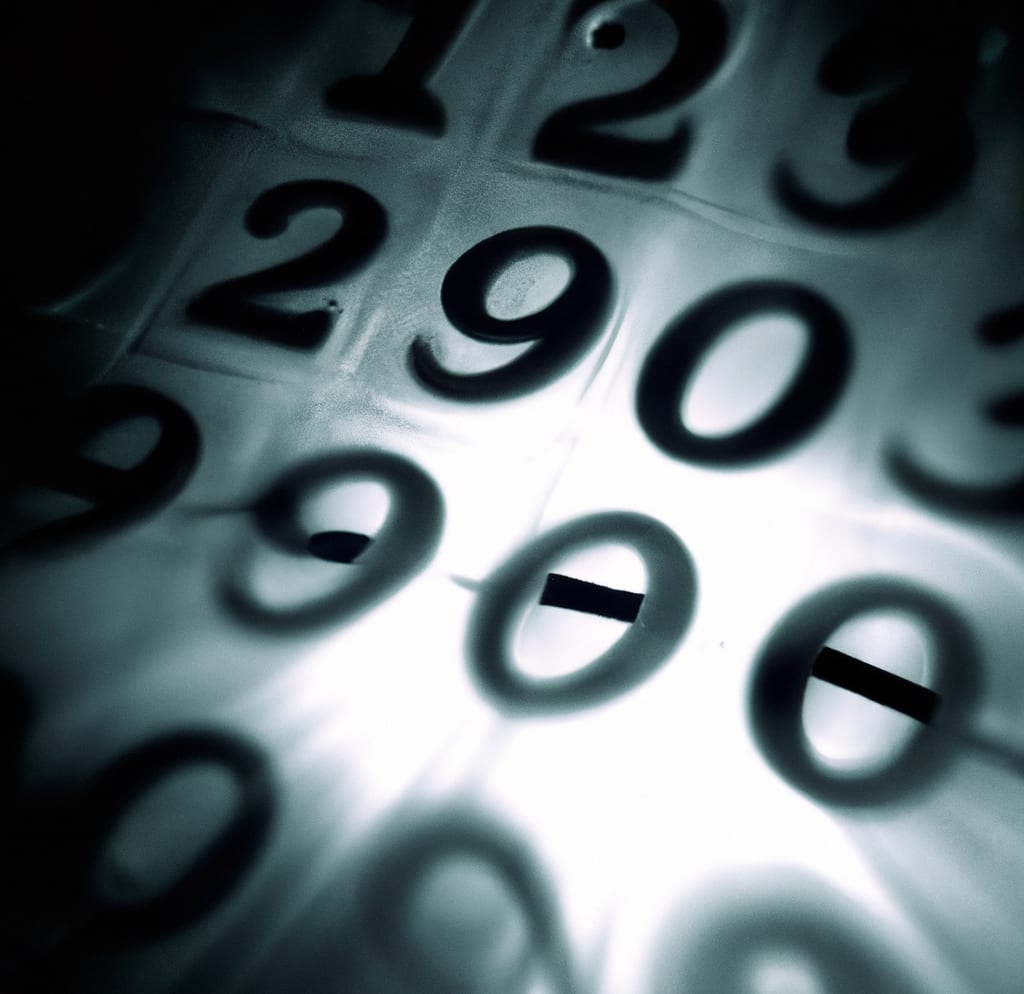10 unknown facts about numbers
This article will provide you with some interesting facts about numbers.

Numbers are an integral part of our everyday lives, but there is often more to them than meets the eye. This article explores some of the lesser-known facts and associations surrounding numbers, from ancient history to modern science. From the development of the concept of zero as a number to the mysterious number 137 in physics, this article delves into the hidden meanings and significance of numbers.
- The number 0 was not considered a number by ancient civilizations, but rather a placeholder or symbol of absence. The concept of zero as a number was first developed by ancient Indian mathematicians around the 5th century A.D. The earliest known written instance of the symbol for zero is in a 3rd-century inscription on the wall of a temple in Gwalior, India. Indian mathematicians understood the importance of zero as a placeholder in mathematical calculations and in the development of the decimal number system. They also developed the concept of negative numbers and the use of zero as a placeholder in the representation of large numbers. The concept of zero was later adopted by the Arabs and then by Europeans during the Middle Ages.
- The number pi (π) is an irrational number, meaning it cannot be expressed as a ratio of two integers. The decimal representation of pi goes on forever and it is an important mathematical constant that appears in many geometric formulas, such as the area of a circle (A = πr²) and the circumference of a circle (C = 2πr). It is also used in many branches of science, including physics and engineering. The value of pi is approximately 3.14159, but it can be calculated to an infinite number of decimal places. Archimedes of Syracuse was one of the first mathematicians to rigorously calculate an approximation of pi in the 3rd century B.C. and since then many mathematicians have tried to calculate pi with more precision.
- The number e, represented by the letter "e" and also known as Euler's number, is an irrational mathematical constant approximately equal to 2.71828. It is the base of the natural logarithm, which is widely used in mathematics and has many important applications, particularly in calculus and probability and statistics. e also appears in many other branches of mathematics such as complex analysis, number theory, graph theory, and it has many applications in physics, particularly in the study of exponential growth and decay. The number e was named after the Swiss mathematician Leonhard Euler who first used the symbol "e" for the number in the 18th century. e also has a special relationship with other mathematical constants such as pi and the imaginary number i.
- The number 1 is the only number that is neither prime nor composite. A prime number is a positive integer greater than 1 that has no positive integer divisors other than 1 and itself. A composite number is a positive integer greater than 1 that has at least one positive integer divisor other than 1 and itself. Since 1 has only one positive integer divisor, which is 1, it is neither prime nor composite. It is considered a special case of numbers as it does not have any distinct prime factors, and it is not composite. It is also the only number that is not composite but has a composite square (1^2 = 1).
- The number 137 is a "mystery number" in physics, as its value in some equations cannot be explained by current theories. The number 137 appears in certain equations in quantum mechanics and in the study of the fine structure constant, a dimensionless physical constant that describes the strength of the electromagnetic interaction. The number 137 is also known as the Sommerfeld fine-structure constant, after the German physicist Arnold Sommerfeld, who first studied it in the early 20th century. The exact value of 137 is not predicted by current theories, making it a subject of ongoing research in physics.
- The number 137, also known as the Sommerfeld fine-structure constant, is a "mystery number" in physics, as its value in some equations cannot be explained by current theories. It is the approximate value of the dimensionless physical constant called the fine structure constant, which describes the strength of the electromagnetic interaction between charged particles and is denoted by the Greek letter alpha (α). The fine structure constant appears in many equations in quantum mechanics and is related to the probability of transitions between energy levels in atoms and molecules. The exact value of 137 is not predicted by current theories, making it a subject of ongoing research in physics. Many theories have been proposed to explain the value of 137, including the possibility that it is related to the structure of the universe at the smallest scales. The search for the explanation of the fine structure constant is considered as one of the greatest unsolved problems in physics and the discovery of a theoretical explanation for this number would have far-reaching implications for our understanding of the fundamental nature of the universe.
- The number 42 is often considered to be the "Answer to the Ultimate Question of Life, the Universe, and Everything" in Douglas Adams' book The Hitchhiker's Guide to the Galaxy. The book is a science fiction comedy series that follows the journey of an unwitting human and his alien friend as they travel through space. The number 42 is a central concept in the book, where a supercomputer called Deep Thought is asked to find the answer to the ultimate question of life, the universe and everything, and it comes up with the answer 42. The meaning of this number and the ultimate question it refers to is not revealed in the book, and is left as a mystery for the readers to ponder.
- The number 13 is considered to be unlucky in some cultures due to superstitions and legends that have arisen around it. Some people believe that it is unlucky because there were 13 people present at the Last Supper, and that the 13th guest was Judas, the betrayer of Jesus. However, the number 13 also has positive associations, such as being the number of lunar cycles in a year. The full moon cycle is approximately 29.5 days, and 13 full moon cycles in a year is approximately 383.5 days, which is close to the 365.25 days in a solar year. This is why ancient cultures used a 13-month lunar calendar. The number 13 also has symbolic meaning in many cultures and religions, such as in Wicca, where there are 13 principles of the craft and 13 full moons in a year. It also has significance in Tarot and numerology. Despite the superstitions associated with the number 13, it has both positive and negative associations depending on the culture and context.
- The number 7 is considered to be lucky in many cultures, and is associated with good fortune, blessings and completeness. It also has a significant meaning in many religious and cultural traditions, such as the seven days in a week, and the seven days of creation in the Bible. It is also associated with completeness and perfection in many cultures. In addition to its religious and cultural significance, the number 7 is also used in many other fields such as psychology, physics, and mathematics. In psychology, there are seven basic emotions, in physics, there are seven colors in the visible spectrum, and in mathematics, the number 7 is considered to be a prime number and is used in many mathematical formulas and theories. Overall, the number 7 is considered to be a lucky number and is associated with completeness and perfection in many cultures and has many other field uses.
- The number 108 is considered sacred in many Eastern religions, and is often used in prayer beads and in the design of temples. In Hinduism, 108 is considered a sacred number and is often used in prayer beads, and it is believed that the 108 beads represent the 108 Hindu deities. 108 is also the number of beads in a mala, which is a necklace of beads used for counting repetitions of a mantra during meditation. In Buddhism, 108 is also considered a sacred number and is used in the design of temples and in the 108 prostrations, a traditional form of devotion. It is also believed that 108 represents the 108 earthly desires in Buddhism, and it is said that to overcome these desires is to reach enlightenment.
Numbers have played a significant role in human history, from ancient mathematical discoveries to modern scientific theories. The number 0, pi, e, 1, 137, 666, 42, 13, 7, and 108 each have their own unique stories and associations, some with deep historical roots, others with ongoing mysteries. From the ancient Indians recognizing the importance of zero to the debate around the number 666 in the Bible, the significance of numbers is a fascinating subject. These facts and associations are just a small glimpse into the complexity and diversity of numbers, and there are many more stories to be discovered.
About the Creator
Enjoyed the story? Support the Creator.
Subscribe for free to receive all their stories in your feed. You could also pledge your support or give them a one-off tip, letting them know you appreciate their work.





Comments
There are no comments for this story
Be the first to respond and start the conversation.